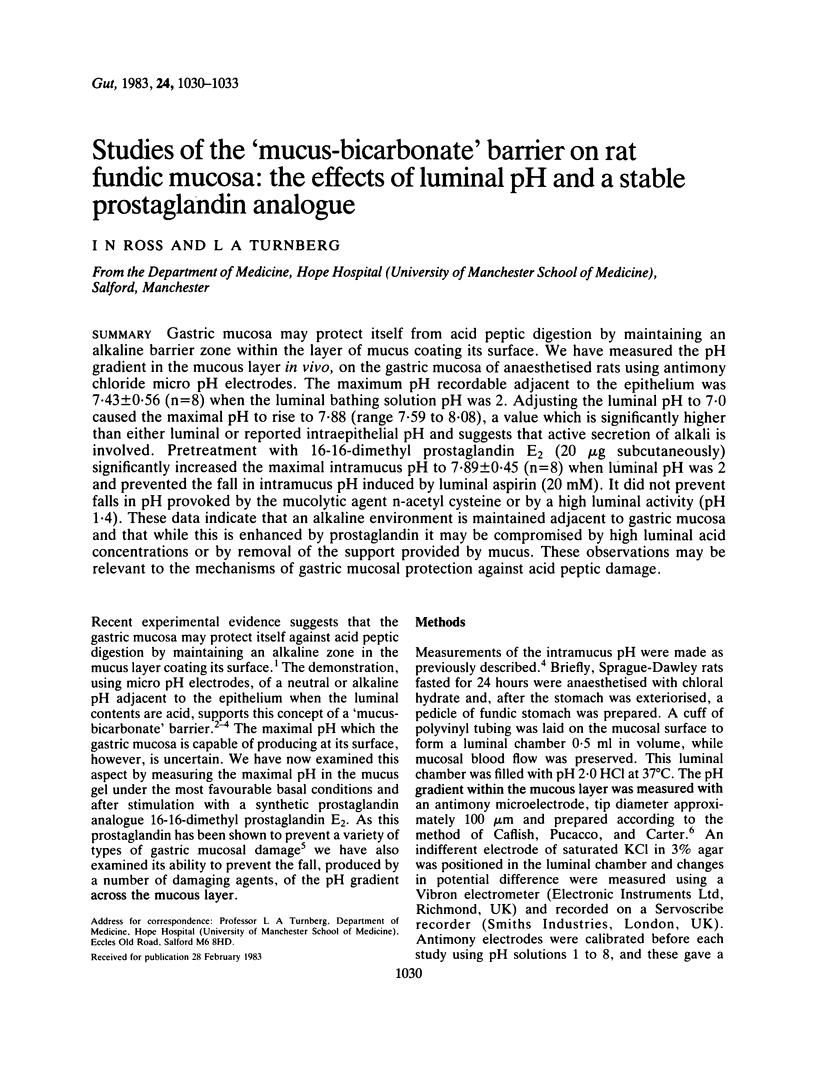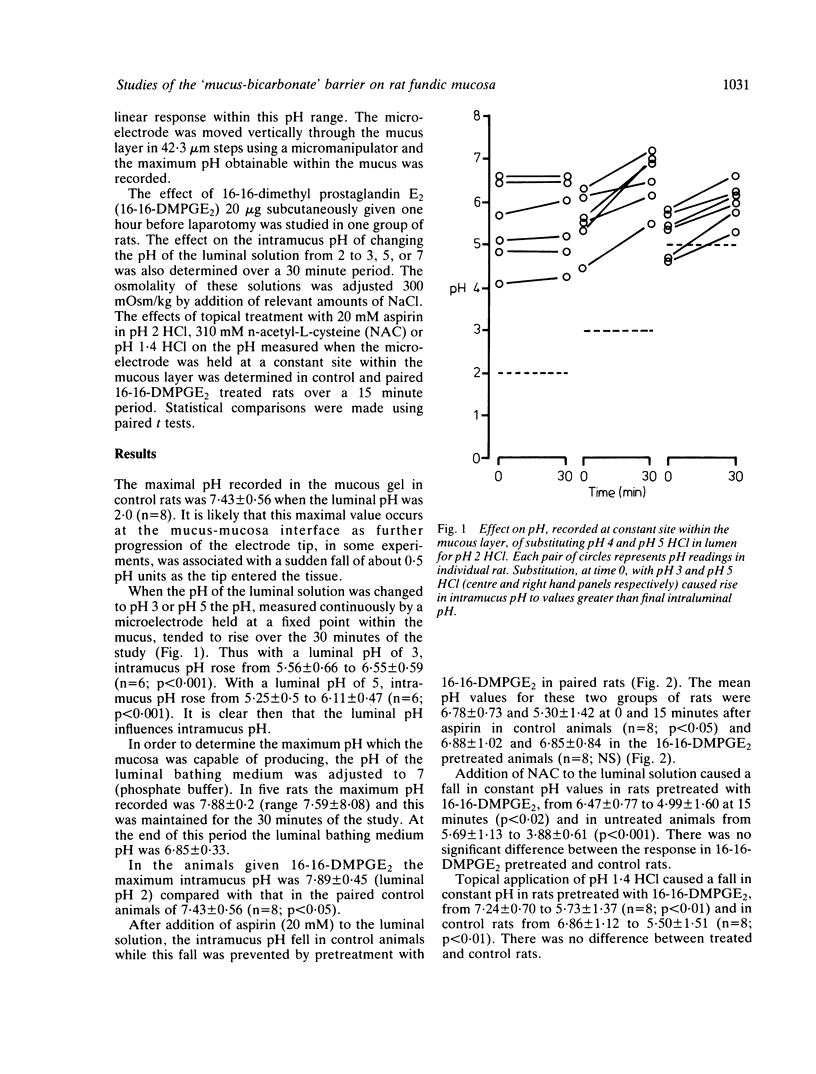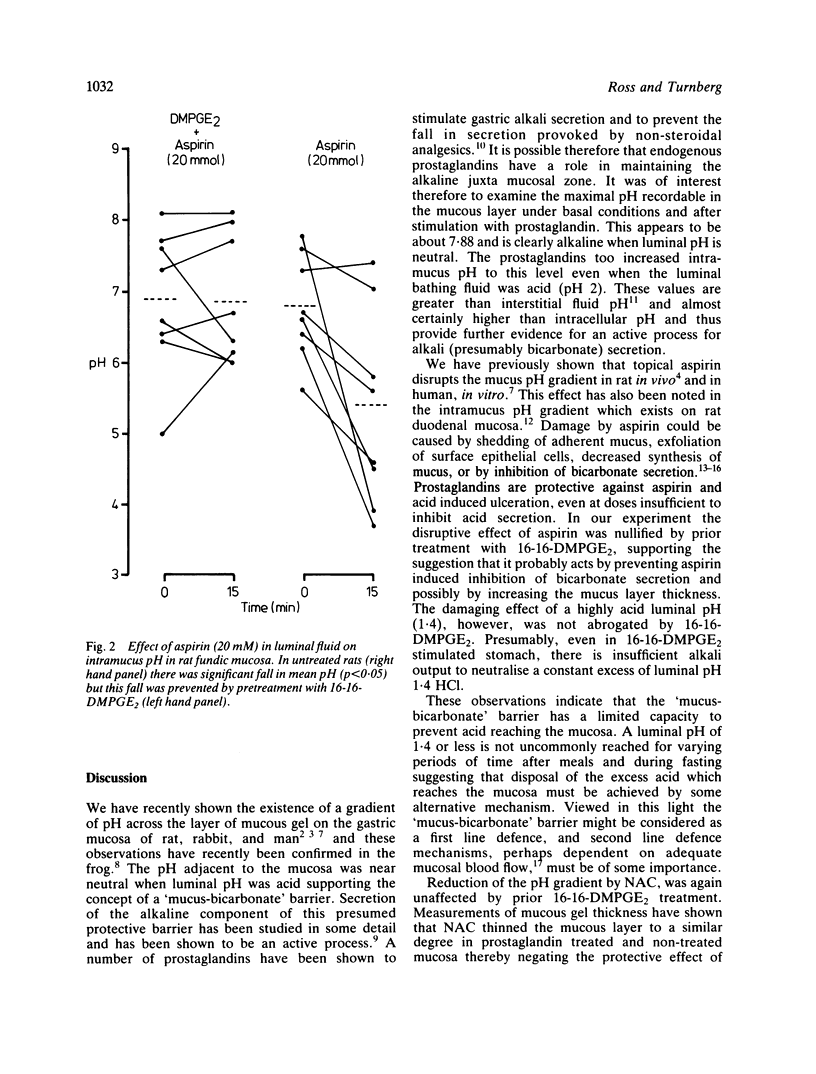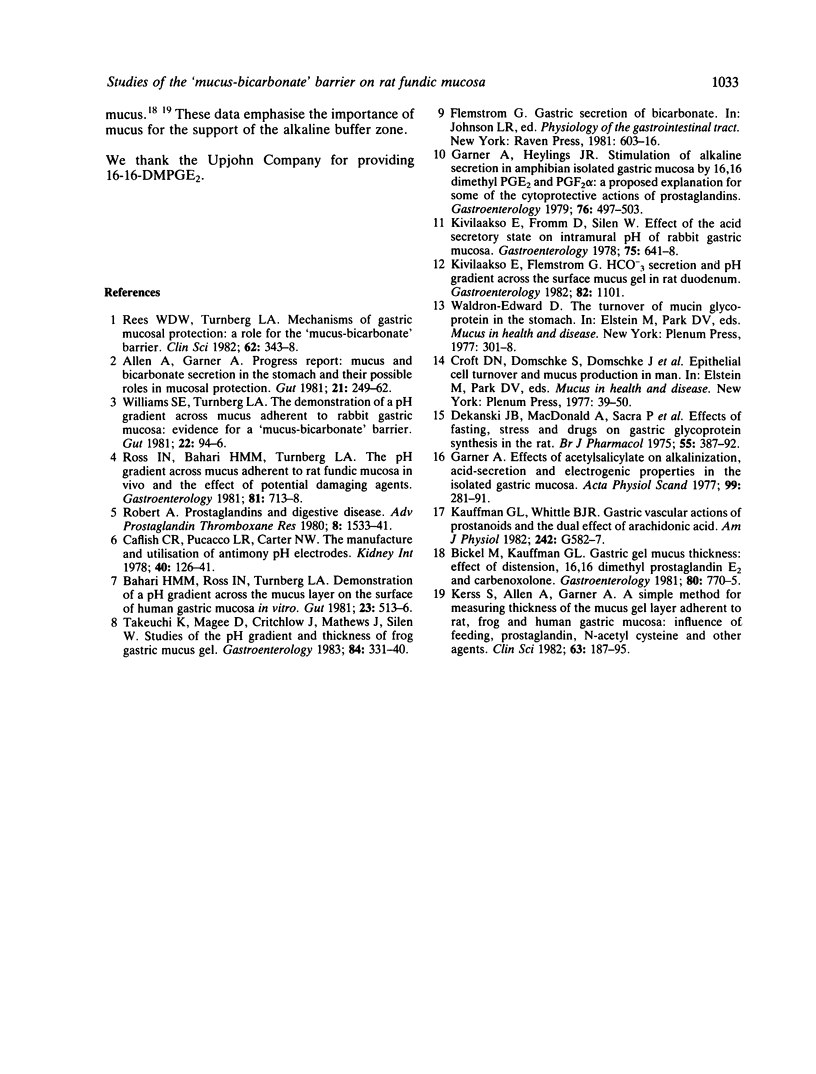Abstract
Gastric mucosa may protect itself from acid peptic digestion by maintaining an alkaline barrier zone within the layer of mucus coating its surface. We have measured the pH gradient in the mucous layer in vivo, on the gastric mucosa of anaesthetised rats using antimony chloride micro pH electrodes. The maximum pH recordable adjacent to the epithelium was 7.43 +/- 0.56 (n = 8) when the luminal bathing solution pH was 2. Adjusting the luminal pH to 7.0 caused the maximal pH to rise to 7.88 (range 7.59 to 8.08), a value which is significantly higher than either luminal or reported intraepithelial pH and suggests that active secretion of alkali is involved. Pretreatment with 16-16-dimethyl prostaglandin E2 (20 micrograms subcutaneously) significantly increased the maximal intramucus pH to 7.89 +/- 0.45 (n = 8) when luminal pH was 2 and prevented the fall in intramucus pH induced by luminal aspirin (20 mM). It did not prevent falls in pH provoked by the mucolytic agent n-acetyl cysteine or by a high luminal activity (pH 1.4). These data indicate that an alkaline environment is maintained adjacent to gastric mucosa and that while this is enhanced by prostaglandin it may be compromised by high luminal acid concentrations or by removal of the support provided by mucus. These observations may be relevant to the mechanisms of gastric mucosal protection against acid peptic damage.
Full text
PDF



Selected References
These references are in PubMed. This may not be the complete list of references from this article.
- Allen A., Garner A. Mucus and bicarbonate secretion in the stomach and their possible role in mucosal protection. Gut. 1980 Mar;21(3):249–262. doi: 10.1136/gut.21.3.249. [DOI] [PMC free article] [PubMed] [Google Scholar]
- Bahari H. M., Ross I. N., Turnberg L. A. Demonstration of a pH gradient across the mucus layer on the surface of human gastric mucosa in vitro. Gut. 1982 Jun;23(6):513–516. doi: 10.1136/gut.23.6.513. [DOI] [PMC free article] [PubMed] [Google Scholar]
- Bickel M., Kauffman G. L., Jr Gastric gel mucus thickness: effect of distention, 16,16-dimethyl prostaglandin e2, and carbenoxolone. Gastroenterology. 1981 Apr;80(4):770–775. [PubMed] [Google Scholar]
- Caflisch C. R., Pucacco L. R., Carter N. W. Manufacture and utilization of antimony pH electrodes. Kidney Int. 1978 Aug;14(2):126–141. doi: 10.1038/ki.1978.100. [DOI] [PubMed] [Google Scholar]
- Croft D. N., Domschke W., Domschke S., Hagel J., Demling L. Epithelial cell turnover and mucus production in man. Adv Exp Med Biol. 1977;89:39–50. doi: 10.1007/978-1-4613-4172-7_3. [DOI] [PubMed] [Google Scholar]
- Dekanski J. B., Macdonald A., Sacra P. Effects of fasting, stress and drugs on gastric glycoprotein synthesis in the rat. Br J Pharmacol. 1975 Nov;55(3):387–392. doi: 10.1111/j.1476-5381.1975.tb06942.x. [DOI] [PMC free article] [PubMed] [Google Scholar]
- Garner A. Effects of acetylsalicylate on alkalinization, acid secretion and electrogenic properties in the isolated gastric mucosa. Acta Physiol Scand. 1977 Mar;99(3):281–291. doi: 10.1111/j.1748-1716.1977.tb10381.x. [DOI] [PubMed] [Google Scholar]
- Garner A., Heylings J. R. Stimulation of alkaline secretion in amphibian-isolated gastric mucosa by 16,16-dimethyl PGE2 and PGF2 alpha. A proposed explanation for some of the cytoprotective actions of prostaglandins. Gastroenterology. 1979 Mar;76(3):497–503. [PubMed] [Google Scholar]
- Kauffman G. L., Jr, Whittle B. J. Gastric vascular actions of prostanoids and the dual effect of arachidonic acid. Am J Physiol. 1982 Jun;242(6):G582–G587. doi: 10.1152/ajpgi.1982.242.6.G582. [DOI] [PubMed] [Google Scholar]
- Kerss S., Allen A., Garner A. A simple method for measuring thickness of the mucus gel layer adherent to rat, frog and human gastric mucosa: influence of feeding, prostaglandin, N-acetylcysteine and other agents. Clin Sci (Lond) 1982 Aug;63(2):187–195. doi: 10.1042/cs0630187. [DOI] [PubMed] [Google Scholar]
- Kivilaakso E., Fromm D., Silen W. Effect of the acid secretory state on intramural pH of rabbit gastric mucosa. Gastroenterology. 1978 Oct;75(4):641–648. [PubMed] [Google Scholar]
- Rees W. D., Turnberg L. A. Mechanisms of gastric mucosal protection: a role for the 'mucus-bicarbonate' barrier. Clin Sci (Lond) 1982 Apr;62(4):343–348. doi: 10.1042/cs0620343. [DOI] [PubMed] [Google Scholar]
- Robert A. Prostaglandins and digestive diseases. Adv Prostaglandin Thromboxane Res. 1980;8:1533–1541. [PubMed] [Google Scholar]
- Ross I. N., Bahari H. M., Turnberg L. A. The pH gradient across mucus adherent to rat fundic mucosa in vivo and the effect of potential damaging agents. Gastroenterology. 1981 Oct;81(4):713–718. [PubMed] [Google Scholar]
- Takeuchi K., Magee D., Critchlow J., Matthews J., Silen W. Studies of the pH gradient and thickness of frog gastric mucus gel. Gastroenterology. 1983 Feb;84(2):331–340. [PubMed] [Google Scholar]
- Williams S. E., Turnberg L. A. Demonstration of a pH gradient across mucus adherent to rabbit gastric mucosa: evidence for a 'mucus-bicarbonate' barrier. Gut. 1981 Feb;22(2):94–96. doi: 10.1136/gut.22.2.94. [DOI] [PMC free article] [PubMed] [Google Scholar]


